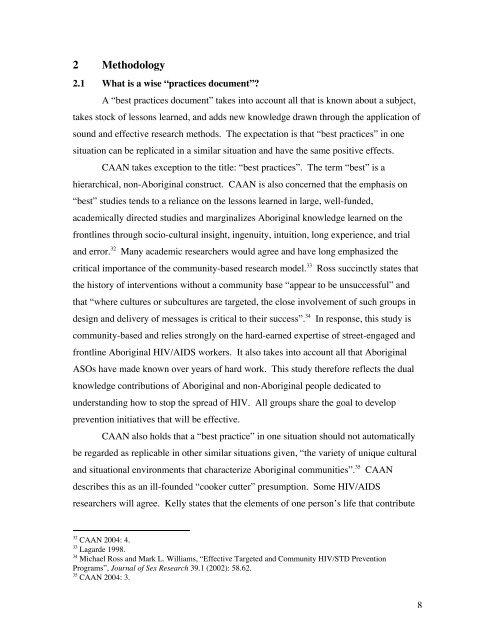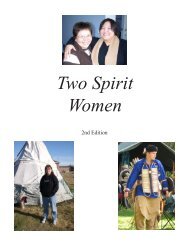Leading an Extraordinary Life: Wise Practices for an HIV ... - 2 Spirits
Leading an Extraordinary Life: Wise Practices for an HIV ... - 2 Spirits
Leading an Extraordinary Life: Wise Practices for an HIV ... - 2 Spirits
Create successful ePaper yourself
Turn your PDF publications into a flip-book with our unique Google optimized e-Paper software.
2 Methodology<br />
2.1 What is a wise “practices document”?<br />
A “best practices document” takes into account all that is known about a subject,<br />
takes stock of lessons learned, <strong>an</strong>d adds new knowledge drawn through the application of<br />
sound <strong>an</strong>d effective research methods. The expectation is that “best practices” in one<br />
situation c<strong>an</strong> be replicated in a similar situation <strong>an</strong>d have the same positive effects.<br />
CAAN takes exception to the title: “best practices”. The term “best” is a<br />
hierarchical, non-Aboriginal construct. CAAN is also concerned that the emphasis on<br />
“best” studies tends to a reli<strong>an</strong>ce on the lessons learned in large, well-funded,<br />
academically directed studies <strong>an</strong>d marginalizes Aboriginal knowledge learned on the<br />
frontlines through socio-cultural insight, ingenuity, intuition, long experience, <strong>an</strong>d trial<br />
<strong>an</strong>d error. 32 M<strong>an</strong>y academic researchers would agree <strong>an</strong>d have long emphasized the<br />
critical import<strong>an</strong>ce of the community-based research model. 33 Ross succinctly states that<br />
the history of interventions without a community base “appear to be unsuccessful” <strong>an</strong>d<br />
that “where cultures or subcultures are targeted, the close involvement of such groups in<br />
design <strong>an</strong>d delivery of messages is critical to their success”. 34 In response, this study is<br />
community-based <strong>an</strong>d relies strongly on the hard-earned expertise of street-engaged <strong>an</strong>d<br />
frontline Aboriginal <strong>HIV</strong>/AIDS workers. It also takes into account all that Aboriginal<br />
ASOs have made known over years of hard work. This study there<strong>for</strong>e reflects the dual<br />
knowledge contributions of Aboriginal <strong>an</strong>d non-Aboriginal people dedicated to<br />
underst<strong>an</strong>ding how to stop the spread of <strong>HIV</strong>. All groups share the goal to develop<br />
prevention initiatives that will be effective.<br />
CAAN also holds that a “best practice” in one situation should not automatically<br />
be regarded as replicable in other similar situations given, “the variety of unique cultural<br />
<strong>an</strong>d situational environments that characterize Aboriginal communities”. 35 CAAN<br />
describes this as <strong>an</strong> ill-founded “cooker cutter” presumption. Some <strong>HIV</strong>/AIDS<br />
researchers will agree. Kelly states that the elements of one person’s life that contribute<br />
32 CAAN 2004: 4.<br />
33 Lagarde 1998.<br />
34 Michael Ross <strong>an</strong>d Mark L. Williams, “Effective Targeted <strong>an</strong>d Community <strong>HIV</strong>/STD Prevention<br />
Programs”, Journal of Sex Research 39.1 (2002): 58.62.<br />
35 CAAN 2004: 3.<br />
8



